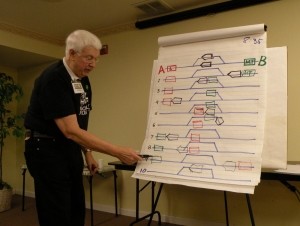By Jeff Moorman
After introductions and announcements the first topic at the March meeting was operation, specifically operation on modules. The 4D NTRAK experience at the Monroe show was cited as an example. Instead of setting up in a big circle and running laps, they set up end-to-end and ran back and forth. Everyone, including the spectators, seemed to enjoy it. Of course, without DCC, it would have been less interesting.
So, we shouldn’t automatically think continuous loops in our own module plans. For example, just 2 standard banquet tables end-to-end would provide a 16-foot long run. And, of course, L and U shaped arrangements are easily possible.
In order to make point-to-point running interesting you would need at least one passing siding (or runaround track) and some spurs for switching. Therefore we should give that type of trackage consideration as we build more modules.
Next up we talked about ways to find out what color things were, if you are modeling an era before the widespread use of color film. Generally that’s any time before the second half of the 20th century. Here are some of the items suggested:
- Paintings are usually in color and can contain a wealth of information about what things looked like and what color they are. Luckily the Internet provides relatively easy access to artwork.
- Contemporary literature, including newspapers and magazines, can have references to the color of things, even though there might be no illustrations at all. National Geographic was mentioned as having color pictures before most others.
- Costume reference books as used for theater and costume design are a super reference as to what people wore at various times in history.
- Advertising posters and signs where done in color long before color photography. There are online and published collections of this material which can be very, very useful.
- Museums seem an obvious choice. And don’t overlook hobby groups, such as farm equipment or automobile enthusiasts. They can be as dedicated to and knowledgeable of the object of their passions as we can be about model railroading.
I have again failed to get the photos ready on time for this posting. So perhaps I shall do a special photo gallery posting sometime soon.
Right now there are 2 things planned for the April meeting. First, we will do the track planning exercise, scheduled for last time that we never got around to. And second, the module kits should be here. So, if you ordered one, come prepared to pay. They are $9.25 for straights and $16.60 for corners regardless of scale. A few are unspoken for, so if you didn’t pre-order, bring your money anyway.
Remember the next meeting is April 7 and the one after that is May 5.
We meet at the Ronald United Methodist Church, 17839 Aurora Avenue North, Shoreline, WA. That is on the west side of Aurora (State Route 99) just north of 175th Street, between the Cadillac dealer and Deseret Industries. Note that there is still a lot of construction along this stretch of Aurora. Therefore, it might be best to be going southbound so you can make a right-hand turn into the church driveway immediately after passing the Deseret location.
Meetings are the first Thursday of each month, except July and August. Enter the lower level of the church from the parking lot at the rear. Doors open around 7:00 PM, announcements at 7:15, and the program starts about 7:30. Hope to see you there or at least sometime on down the line.



